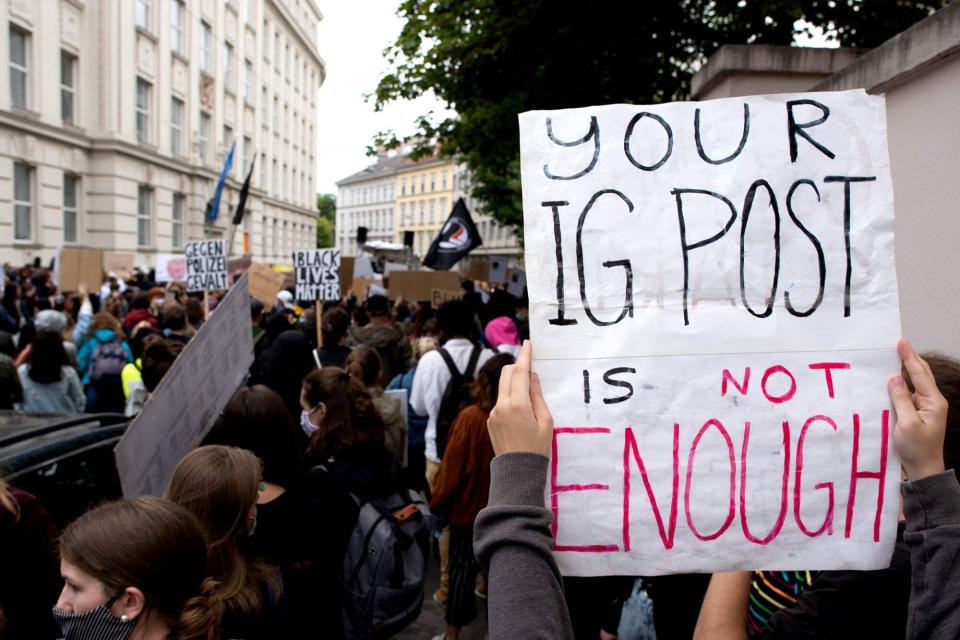How to Take Your Activism Offline and Be an Ally in Real Life
Around this time last year, Instagram was flooded by black squares meant to show solidarity for the Black Lives Matter movement. Whether it was well-intentioned or not, individuals and corporations alike got called out for lazy activism (or slacktivism) and, worse, performative activism. In some ways, it was a sign of the moment, the pandemic had made it difficult for some people to take to the streets or advocate for equality IRL. In others ways, though, it felt like a good start but not necessarily enough.
As the world begins to open up, it might be time to think harder about what it means to be an ally. Here's what you need to know if you want to move beyond online activism — though there is a time and place for that, as well — and take your actions into the real world.
From Instagram to IRL.
Protest Guide is an important resource for anyone looking to head out to rallies, whether they're a first-timer or a seasoned protestor. Taking discussions from Instagram comments and other social media platforms into in-person interaction is a logical step to share ideas and make a statement, but protests are often met with counter-protests, so people on both sides should be prepared for any situation. Think of the online posts as the planning phase and the protests as a chance to put those plans into motion.
According to Mashable, there's a way to blend online action with real-life work. University of Pennsylvania professor Dr. Sarah Jackson, Northeastern University professors Dr. Moya Bailey, and Dr. Brooke Foucault Welles, authors of Hashtag Activism: Networks of Race and Gender Justice, argue that virtual activism can mash-up "the speed of communication on the internet with careful organizing," which lets organizers build "inclusive, connected movements."
"Across historical periods, social movements have relied on public debate, discussion, and storytelling," Jackson said. "We see the same thing today."
That storytelling is most clearly seen in the sleek infographics that get shared across Instagram. The New Yorker's Jane Hu called the posts a catalyst for getting people to talk and the physical protests as a way for the ideas to be sustained offline. A graphic will get lost in a feed, but going meeting people and creating connections — and commitments to participate in future events together — can keep momentum going.

Getty Images
RELATED: Why the "Blackout Tuesday" Initiative on Instagram Is Drawing Criticism
Use the power of search.
Alyssa Bowen, a doctoral candidate in history at the University of North Carolina at Chapel Hill, told NBC News that online activism pushing people to look for more tangible ways to make change isn't new. She mentioned the Occupy Wall Street movement in the early 2010s and the Arab Spring as examples of issues that started online and manifested into in-person protests.
"You're seeing people staying at home without a ton to do except watch Netflix and go on Twitter, and I think people took great notice of what's going on even more than usual, because they had real-time access to what was going on at the protests," she said.
The Pew Research Center conducted a survey in June, which showed that 54% of social media users aged 18 to 29 said that they "used social media platforms in the last month to look for information about rallies or protests happening in their area."
Online resources like Facebook and Twitter (search "protest", "march for," or "car caravan" under Events and follow local organizations) can make it easy to get involved and take the first steps to fight for real-world change.
RELATED: 15 Anti-Racism Resources to Keep You Informed
Connect with organizations for even bigger (and continued) impact.
People looking to get involved can look for resources through organizations like March For Our Lives, which advocated for voter registration during the 2020 election, and The Poll Hero Project, an organization that pushed young people to apply to be poll workers. QRIUS cited Australian climate change protests as another example of online activism that developed into protests. Existing organizations that have clear missions are already set up to give voices a platform and amplifying those new ideas creates an ongoing dialogue that can spark continued change. Follow them to get details on future events.

